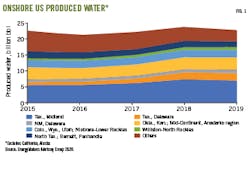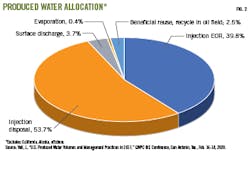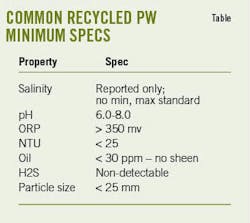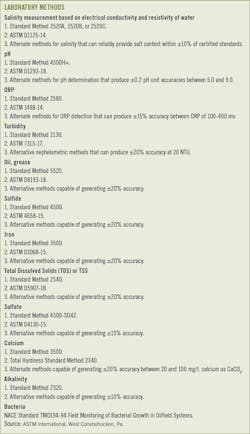Industry association advances completion brine standards
Morris Hoagland
Jade Dragon LLC
Lafayette, La.
Laura Capper
Energy Makers Advisory Group
Houston
The Produced Water Society (PWS), an independent third-party association of oilfield water professionals, has established a common spec guideline for completion brine (CB) used in fracturing fluids. The oil and gas industry has produced an enormous amount of water from conventional wells. Unconventional production with horizontal drilling and hydraulic fracturing has added substantially to the pool of produced water (PW) via flowback of spent fracturing fluids and formation connate water. The large amount of water required for fracturing, 400,000 bbl/well or more, has driven growth in PW recycling to preserve fresh water sources. Making this recycled water tradeable on commodities markets requires a set of water quality standards. A wide range of stakeholders, including water midstream companies, operators, services providers, pumping companies, technology vendors, and oilfield water specialists were consulted in developing common spec for CB.
Most flowback water is in West Texas, but substantial amounts also exist in the Midcontinent, North Dakota, and the Rockies. Fig. 1 shows produced water volumes in both conventional and unconventional plays in the US, excluding California, Alaska, and offshore. Areas with unconventional activity contribute substantial volumes of water.1
Early in the development of shale plays, most water was disposed of in Underground Injection Control (UIC) Class II saltwater disposal (SWD) wells. Eventually, high-salinity compatible fracturing fluids were developed to use recycled PW, but these fluids represent only a small fraction of the produced water stream. Fig. 2 shows that injection for disposal and injection for enhanced oil recovery (EOR) are leading end-streams for PW, with frac water recycling making up less than 3% of the total. Presently, produced water volumes are 200-400% more than annual completion source water demand, offering significant opportunity for reuse elsewhere.
PW recycling was widely adopted early in developing the Marcellus shale due to the high logistics cost of transporting water to disposal wells in Ohio and West Virginia. The practice of PW recycling has been gradually adopted in the Midland and Delaware portions of the Permian basin. Currently, more than 90% of produced water from unconventional wells is recycled in Utica and Marcellus shales and about 15% in the Permian basin. Other shale plays are recycling little produced water. Overall, produced water recycling in unconventional plays is probably 10-15%.
As treatment technologies have improved and scales of operation have grown, it is now often more cost effective to recycle PW than to dispose of it in SWD wells. Development of the water midstream industry has created a new scale of operation that makes recycled PW more cost effective.2
PW is becoming freely traded. Legislation in Texas, and recent changes in New Mexico’s House Bill 546, allow operators to freely trade water, which will facilitate more trading and reuse. These developments require a set of standards for water quality to set commodity pricing.
A limitation against wider PW use has been the broad range of operator specifications for clean brine (CB) quality used in their completions. Midstream water companies may employ water treatment packages to meet the most demanding customer specifications, and since most customers may not require these high specifications, midstream companies are probably overshooting quality specifications for the bulk of the market and not using their money as efficiently as possible.
If the industry was to accept a common spec for CB quality, midstream companies could treat PW at greater scale and reduce unit costs. A further, and perhaps more important, advantage is that a common spec would allow water midstream companies to share CB across pipeline systems. Sharing CB between adjoining water networks would substantially reduce the required amount of CB storage capacity, a major capital expenditure for water midstream companies. Enlarging the CB pipe network also would result in piping water directly to completion sites instead of going into surface storage ponds where its quality naturally degrades over time, requiring additional treatment.
The common recycled water quality spec proposed by PWS is not intended to meet every operator’s internal spec for completion water. The goal is to provide CB that is suitable for use coming off a pipeline. Operators sourcing CB for frac fluids will be able to plan for a minimum water quality at a low price point. Operators may then choose additional polishing treatment or freshwater blending at wellhead sites to meet tighter internal specs. The goal is to reduce both overall costs of water management and reliance on freshwater. It is fully anticipated that the proposed spec will be updated as experience is gained in the industry working with this set of parameters.
Water quality parameters
There are a wide range of parameters associated with quality of CB generated from PW. Some of these can be measured quickly in the field, while others require extensive time to measure in offsite labs. In addition to non-timely results, offsite lab analysis has the additional disadvantage that samples can change composition over time and may not be representative by the time they are tested. The common spec therefore needs to establish simple parameters that can quickly be measured in the field. Most useful will be properties which can be measured real-time with online instruments reporting directly to water midstream companies’ supervisory control and data acquisition (SCADA) systems. These data may also be available to purchasers taking water off the pipeline.
Adopted parameters include:
- Salinity.
- pH.
- Oxidation-reduction potential (ORP).
- Turbidity.
All can easily be measured online in real time. The resulting quality standard is referred to as SpOT.3 The consensus amongst the stakeholders of acceptable values for these parameters is shown in the Table. This common spec is the recommended guideline for minimum acceptable criteria for CB treatment. These parameters would be reported by entities putting water into CB pipelines for sale from their treatment sites.
There are parameters beyond SpOT that concern some stakeholders, including bacteria, iron, oil, H2S, total sulfides, corrosivity, and solids particle size. Water quality consistent with SpOT parameters will address or mitigate these concerns.
Discussion
CB salinity may vary throughout the unconventional play and can fluctuate in individual wells over the course of their productive lives. This parameter will be measured via online conductivity probe, correlated to approximate salinity value, and reported. The pH is easy to measure and control with online probes.
Online probes also measure ORP. Water with ORP > 350 mv should be relatively free of bacteria. This level of ORP should oxidize any dissolved iron to the ferric state, which will precipitate. A combination of ORP and < 50 nephelometric turbidity units (NTU) means that iron and oil levels should be acceptable. While the initial SpOT recommendation included ORP > 250 mv, several operators have expressed a strong preference for water going into the sales line to have ORP of 350-400 mv, since some excess oxidant will be consumed by reactive species in the CB stream. This level may be reevaluated during the revision cycle for this spec.
Measurement of turbidity can be performed with an online light transmittance probe measuring NTU. Turbidity is a measure to determine level of total suspended solids (TSS). Any present soluble iron will be oxidized to the solid ferric form (based on the ORP and pH parameters) and will show up as turbidity.
Turbidity does not give any indication of particle size. Large particles need to be captured in 25-mm filters at the point where CB is transferred to the sales line. It is advisable for water buyers to also filter water at points of use to required effluent particle size. This would capture any solids picked up in the pipeline during transit.
It is in the water treater’s interest to capture as much of the oil as possible that comes into their treatment facility, as recovered oil is a revenue stream. Furthermore, oil would likely interfere with downstream water treatment unit operations, driving up costs. In most cases, oil coming through would show up as turbidity. Furthermore, at ORP > 350 mv, some oil is oxidized. However, some high-API gravity unconventional oils may not register as turbidity.
The 30-ppm oil limit intends to avoid oil sheens on CB storage ponds receiving this water. Free-phase oil sheens would require expensive bird protection measures around ponds. Oil can be measured online with fluorescence technology. This is a more expensive instrument and must be calibrated when there is any change in source water. Studies have also indicated that there is great uncertainty associated with oil-in-water data obtained using existing laboratory-based methods, whether gravimetric, infrared absorption-based, or gas chromatography with flame ionization detection. This uncertainty may be as high as ±50% (at a 95% confidence level). The use of online oil-in-water monitors, particularly those installed inline, could reduce uncertainties associated with current sampling and analysis practices.4
Operators will not accept CB waters with detectable H2S. This parameter poses significant risk to personnel, as well as a corrosion risk for facilities. At ORP > 350 mv, H2S should be oxidized to elemental sulfur. High levels of H2S will result in significant elemental sulfur that will require separation. Failure to do so will result in unacceptable turbidity levels.
Some participants suggested a total sulfides spec would be helpful. Water containing high sulfides could be mixed with lower-pH water and create toxic H2S gas. Since this parameter cannot be readily measured with online instrumentation, it is not included in the initial spec. CB buyers must be aware of this potential if they are blending waters with significant pH differences.
Particle size can be measured with online laser spectroscopes, which are expensive instruments. A low-cost and practical approach is to filter CB with < 25-µm filters before sending it to pipelines. Buyers may refilter at receiving locations if they have tighter particle-size specs. Filtration with nominal 25-µm media will assure removal of 99.9% of particles exceeding 50 mm. Filtration must be the last step in the process before water enters the sales pipeline. No additional chemistry or other fluids should be added downstream from this final treatment.
Other best practices include limits on:
- Bacteria. Several methods are available for measuring bacteria levels. The long-established approach using bioassays takes 5-21 days and is not practical. Several new instruments are available that provide much quicker indications. However, by maintaining ORP > 350 mv, there should be minimal living bacteria in the water. This ORP level may eliminate the requirement for further bacteria monitoring. This spec does not, however, eliminate the potential need for water buyers (operators) to add oxidant or biocide at points of use.
- Corrosivity. Online instruments are available that can indicate a water’s corrosivity. Most produced water systems use high-density polyethylene (HDPE) pipe, which is generally impervious to chemicals typically used in oilfield waters. Some of the older legacy pipeline systems were constructed with steel pipe and are vulnerable to corrosion. It is up to owners of steel pipelines to determine the corrosivity parameters needed to protect their pipelines’ integrity.
Operators may have concerns about both scaling and water compatibility with the formations in which PW will be injected. Such factors might impact how much freshwater is needed for blending or how much chemistry is required to prevent scaling. Scaling potential is specific to the waters being blended, whether on surface when mixing waters or downhole when frac water mixes with connate water. Since these issues vary widely and are linked specifically to the working formation, no attempt was made to address these issues in the initial guidelines.
Instrumentation
Accurate analyses and chemical treatment can be achieved using proven advanced treatment systems.5 The keys to delivering quality data are proper maintenance of instruments and regular calibration. Laboratory instruments have historically been calibrated against laboratory-produced solutions measured using standard test methods. This approach is not practical in the field. Most online instruments are now calibrated against standard calibration solutions from instrument manufacturers or chemistry vendors. These solutions are readily available and convenient to use. An exception is the oil-in-water measurement with fluorescence technology, which requires calibration against a solution formulated with the target oil.
Laboratory methods
These methods are typically applied in offsite labs and are generally impractical for making infield measurements. They are useful, however, in crosschecking against online data. Most of these methods are consistent with current National Environmental Laboratory Accreditation Conference (NELAC) standards.6
Depending on the formation where the CB buyer (operator) is using recycled water, it may be necessary to measure other constituents (e.g. iron, sulfide, alkalinity, sulfate, and barium) or other properties (e.g. corrosivity, saturation indices, and tendencies to scale). Calibration methods will need to be appropriate for the expected brines and be capable of specifying minimum detection limits. Calibration accuracy and test methods should be dictated by specifications. The box presented earier in the article contains a list of testing methods that can be considered. Alternate methods may also be acceptable if they match the minimum detection limit (MDL) called for by the specification and can generate the recommended accuracy at twice the MDL.
References
- Veil, J., “U.S. Produced Water Volumes and Management Practices in 2017,” GWPC UIC Conference, San Antonio, Tex., Feb. 16-18, 2020.
- Scanlon, S.I., Yang, Q. and Reedy, R.C., “Will Water Issues Constrain Oil and Gas Production in the U.S.?,” Environmental Science and Technology, Vol. 54, No. 6, February 2010.
- Horn, A., D., “Trading Water at Terminals,” Shale Play Water Management, November-December 2019.
- Yang, M., “Effective Treatment and Handling of Produced Water,” Journal of Petroleum Technology, Vol. 72, No. 2, February 2020.
- Cherednichenko, N., “Keys to Better Water Management: Seeking Sustainability Amid the Chaos,” Journal of Petroleum Technology, Vol. 72, No. 5, May 2020.
- NELAC Institute.
- ASTM International, West Conshohocken, Pa.
The authors
Morris Hoagland, P.E. ([email protected]) is managing director of Jade Dragon in Lafayette, La. He has a BS (1976) and MS (1978) in chemical engineering from the University of Louisville. He has served on the board of directors for the Produced Water Society since 2013.
Laura Capper ([email protected]) is chief executive officer of EnergyMakers Advisory Group and CAP Resources. Laura holds a BS (1983) in electrical engineering with a minor in bioengineering and computer science from Rice University, Houston. She is active with the Produced Water Society and the New Mexico Produced Water Recycling Consortium.



